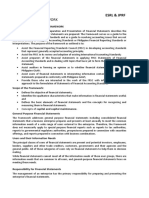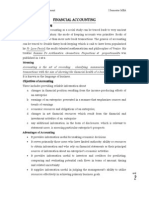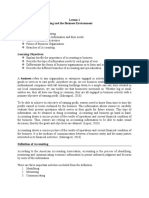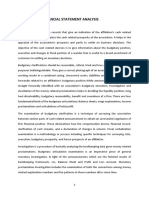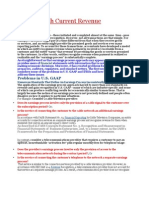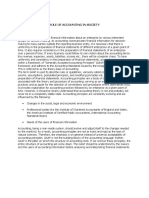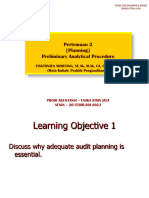Lesson-2 Generally Accepted Accounting Principles and Accounting Standards
Uploaded by
Karthigeyan BalasubramaniamLesson-2 Generally Accepted Accounting Principles and Accounting Standards
Uploaded by
Karthigeyan BalasubramaniamLesson-2 Generally Accepted Accounting Principles and Accounting Standards Learning Objectives To understand the meaning of GAAP To know
To know the basic accounting principles To understand the conventions To have an overview of accounting standards To understand the system of bookkeeping To understand the nature of double entry system To learn about the stages of double entry system
Introduction Accounting aims to provide financial information about an enterprise to various interested groups for decision-making. As accounting communicates financial information for decisionmaking to many parties outside the reporting business entity, it is necessary that there is uniformity in the preparation of financial statements of different enterprises at a given point of time. It also requires consistency in the preparation of financial statements of an enterprise over a period of time. If every business could follow its own notion about the accounting terms like revenue, expenses, assets, liabilities, income etc., there will be complete chaos. To have uniformity and consistency in the preparation of financial statements, accounting operates within a framework of Generally Accepted Accounting Principles (GAAP), follows a conceptual framework and adheres to the Accounting Standards (AS) issued by the recognized regulatory body. This is referred to as the theory base of accounting. The term GAAP is used to describe rules or guidelines, variously called concepts, conventions, axioms, assumptions, postulated principles, modifying principles etc., developed for the preparation of financial statement. Yorston, Smith and Brown have defined accounting principles as the body of doctrines commonly associated with the theory and procedure of accounting, serving as an explanation of current practices and as guide for the selection of conventions and procedures where alternatives exist. Thus, it provides explanation for accounting practices followed by an enterprise at a given point of time. However, it should be clearly understood that accounting theory is not and probably will never be in a completely stable state. Accounting principles are constantly evolving and are influenced by the following: Changes in the social, legal and economic environment Professional bodies like the Institute of Chartered Accountants of India, the American Institute of Certified Public Accountants, International Accounting Standards Board etc. Needs of the users of financial information
Accounting, being a man made system, should evolve and adjust itself to the changes needed by the mankind. As a result, accounting principles are not as exact and rigid as the laws of natural sciences. Therefore, the emphasis is on general instead of universal acceptability of
accounting principles. The GAAP are not the building blocks of the accounting language. Rather, they are the pillars on which the structure of accounting is resting. If we remove these principles, the entire structure of accounting will come down. The GAAP should be understood by the makers and the users of accounting information before analyzing and interpreting financial statements. The GAAP includes the following concepts: Accounting entity Stable money measurement Going concern Accounting period Cost Revenue recognitions (or realization) Expenses recognition Matching (or accrual) Full, fair and adequate disclosure Dual aspect (or duality) Verifiable objectivity (neutrality and reliability) Materiality Consistency Conservatism Timeliness Industry practices Substance over form
Of these, the first four concepts are the most basic assumption on which accounting structure rests. The next six are the basic accounting principles which help us in ascertaining the result of a business entity. However, we are essentially operating in a social system which is bound to be inexact. Hence, we need to be flexible in our approach. The basic knowledge needs to be modified due to changing circumstances/situations to enhance the utility of the information generated by the accounting system. The next six concepts serve the same purpose. Accounting Standard on Disclosure of Accounting Policies (AS-1) Issued by ICAI, it recognizes that the fundamental accounting assumptions while drafting accounts of an enterprise are going concern, matching (or accrual) and consistency. If these are followed, disclosure is not necessary. It further emphasizes that the enterprise should consider prudence and substance over form and materiality as considerations in the selection of accounting policies, where accounting policies are defined as "referring to the specific accounting principles and the method of applying those principles adopted by the enterprise in the preparation and presentation of financial statements." The end result of the application of these accounting principles is the preparation of meaningful financial statements. These statements should have some qualitative characteristics. The qualitative characteristics are attributes that make the information provided in financial statements useful to the users. These are as follows: 1. Accounting Entity
Accountants treat a business as distinct from the persons who own it. Then, it becomes possible to record the transactions of the business without the proprietor also. The concept of separate business entity is applicable for all types of organizations like sole proprietorship, partnership etc. where the business affairs are free from the private affairs of the proprietor or partner. 2. Money Measurement
Accounting records normally those transactions which are being expressed in monetary terms. Measurement of business events in monetary terms helps in understanding the state of affairs of the business in a much better way. For example, if a business owns two factory buildings, five lathe machines and Rs. 1,00,000 as cash at bank, we cannot add these numbers so as to produce a meaningful result. However, if we say the value of two factory buildings is Rs. 10,00,000, the value of five lathe machines is Rs. 5,00,000 and cash of Rs. 1,00,000, we can add these values and say that the value of assets owned by the business is Rs. 16,00,000. This is definitely informative and useful. 3. Going Concern Concept
It is assumed that the business will exist for a long time and transactions are recorded from this point of view. Based on this concept, the accountants, while valuing assets, will not consider the forced sale value of assets (market value), but the assets, normally, will be reflected at the cost of acquisition minus depreciation. Similarly, depreciation is provided based on the expected life of the assets. The concept, however, does not imply the permanent continuance of the business. The underlying presumption is that the business will continue in operations long enough to charge against income the cost of fixed assets over their economic lives and to pay the liabilities when they fall due. This concept is applicable to the business as a whole and not for a particular division or branch. Merely closing of a branch or division may not adversely affect the ability of the enterprise to continue other businesses normally. Once the business goes in to liquidation or becomes insolvent, this concept does not apply. In other words, the going concern status of the concern will stand terminated from the date of appointment of a receiver. 4. Accounting Period Concept
According to this concept, the life of a business is divided into appropriate segments of time, say 12 months, for studying the results. While the life of a business is considered to be indefinite, according to the going concern concept, the measurement of income and studying the financial position of the business after a very long time would not be helpful in taking corrective steps at the appropriate time. Therefore, it is necessary that after each segment of time interval the management should review the performance. The segment of time interval is called accounting period, which is usually a year. At the end of each accounting period, an income statement and a balance sheet is prepared. The income statement discloses the profit or loss made by the business during an accounting period. The balance sheet discloses the state of affairs of the business as on the last date of the accounting period. The term conventions includes those customs or traditions which guide the accountants while preparing the accounting statements. 5. Cost Concept
Transactions are entered in the books of account at the amounts actually involved. An asset is ordinarily recorded at a price at which it has been acquired. For example, a plot of land purchased by a firm for Rs. 5,00,000 would be recorded at this value irrespective of its current market price. Cost concept has the advantage of bringing objectivity in the presentation of the financial statements. In the absence of this concept, the figures shown in the accounting records would have to depend on the subjective view of a person. 6. Realization Concept
Accounting is a historical record of transactions. It only records what has happened. It does not anticipate events, though anticipated adverse effects of events that have already occurred are usually recorded. For example, A places an order on B for supply of certain goods. Upon receipt of the order, B procures raw material, employs labor, and produces and delivers the goods to A. In this case, the sale transaction will be recorded in the books of B only when the goods are delivered and not upon the receipt of an enforceable purchase order from A. There are certain exceptions to this concept which are as follows: i) In the case of hire-purchase transaction, the ownership of the goods passes on to the buyer only when the last installment is paid, but sales are presumed to have been made to the extent of installments received and installments outstanding (installments due but not received). In the case of contract accounts, though the contractor is liable to pay only when the whole of contract is completed as per terms of the contract, the profit at the end of accounting year is calculated on the basis of the work completed and certified by a competent authority.
ii)
7.
Expenses Recognition
Cost is the total outlay or expenditure on acquiring resources required for the production of goods or rendering of services. Cost of resources utilized and lost during a particular period is termed as the expired cost or expense and is charged to the revenue of the period to obtain information about income. Costs of the resources remaining unutilized or unexpired at the end of the period are carried forward to the next accounting period and are termed as assets. 8. Accrual Concept
The accrual system is a method whereby revenue and expenses are identified with specific period of time like a month, half year or a year. It implies recording of revenue and expenses of a particular accounting period whether they are received/paid in cash or not. Under the cash system of accounting, the revenue and expenses are recorded only if they are actually received/paid in cash irrespective of the accounting period to which they belong. But under accrual method, the revenue and expenses relating to that particular accounting period only are considered. 9. Disclosure
Apart from the statutory obligations, good accounting practice also demands that all significant information should be disclosed fully and fairly. The financial statements have to be prepared honestly and should disclose the information which is of material interest to the
owners, present and potential creditors, and investors. Whether something should be disclosed or not will depend on whether it is material or not. Materiality depends on the amounts involved in relation to the assets group involved or profits. In the case of financial statements of a limited company, the practice followed is to append the notes to the accounts and disclose significant accounting policies. This is in pursuance of the convention of full disclosure. 10. Dual Aspect Concept
Each transaction has two aspects. With every increase in the money owned to others, there should be an increase in assets or loss. Thus, at any time the accounting equations is as follows: Assets = Liabilities + Capital, or alternatively Capital = Assets - Liabilities For example, a proprietor brings in Rs. 1,00,000 in cash as capital to start a small business. Rs. 1,00,000 is the capital and corresponding amount of Rs. 1,00,000 will appear as cash in hand (assets). 11. Verifiable Objectivity
According to this concept, all accounting transactions should be evidenced and supported by objective documents. These documents include invoices, contracts, correspondence, vouchers, bills, pass books, cheque books etc. Such supporting documents provide the basis for making accounting entries and for verification by the auditors later on. This concept also has its limitations. For example, it is difficult to verify internal allocation of costs to accounting periods. 12. Materiality
According to this convention, the accountant should attach importance to material details and ignore insignificant details. This is because otherwise accounting will be unnecessarily overburdened with minute details. The question what constitutes material details is left to the discretion of the accountant. Moreover, an item may be material for one purpose while immaterial for another. The term materiality is a subjective term. The accountant should regard an item as material if there is a reason to believe that knowledge of it would influence decision of the informed investor. According to Kohler, Materiality means characteristic attaching to a statement, fact or item whereby its disclosure or method of giving it expression would be likely to influence the judgment of a reasonable person. 13. Consistency
The accounting practices should remain the same from one year to another. For example, consistency in valuation of stock in trade or in method of charging depreciation. If the stock has been valued by adopting the principle of cost or market value, whichever is less, the same principle has to be consistently followed year after year. Similarly, the method of charging depreciation, either straight line or written down value method, has to be consistently followed. This is necessary for the comparison of results. However, consistency does not mean inflexibility. In the case of change in law or from the point of view of improved
reporting, this convention is broken and then adequate disclosure, as to the impact on the profit due to such change, has to be mentioned in the notes appended to the accounts. 14. Conservatism
Financial statements are usually drawn up on a conservative basis, especially in the initial stages when the anticipated profits, which were accounted, did not materialize. This results in less acceptability of accounting figures by the end-users. Therefore, accountants follow the rule anticipate no profits but provide for all possible losses. Similarly, based on this convention, the inventory is valued at cost or market price whichever is less. Necessary provision for bad and doubtful debts is made in the books of account. Window-dressing, i.e. showing a position better than what it is, is not permitted. It is also not proper to show a position substantially worse than what it is. In other words, secret reserves are not permitted. Therefore, this convention has to be applied with reasonable caution and care. 15. Timeliness
Financial reports should be timely to have any usefulness for decision makers. Timeliness in financial reporting requires estimation of depreciation, provision for bad and doubtful debts, provision for discount etc. to prepare the financial statements of different accounting periods. 16. Industry Practice
Sometimes, practice prevailing in a particular industry is given precedence over generally accepted accounting principles. For example, valuation of gold on the basis of market price, agriculture products on the basis of minimum support price determined by the government etc. 17. Substance over Form
The accounting treatment and presentation in the financial statements of transactions and events should be governed by their substance and not merely by their legal form. Hence, when goods are purchased on hire-purchase basis, the property in goods is transferred to the buyer on the payment of the last installment only. However, the buyer for all practical purpose uses the goods as if he is the owner of the goods in question from the date of acquisition. This aspect is reflected in the books of the buyer, normally by recording the asset at its cash price at the time of payment of initial amount (down payment). Hence, substance should always override the legal form. To quote Shiv Khera, Attitude can make or break you. Success is vital but not without a feeling of fulfillment, like good looks are not worth without goodness. So, always choose substance over form. Never the reverse. Accounting Standard Accounting communicates the financial results of business to various parties by means of financial statements which have to exhibit a true and fair view of the state of affairs. Like any other language, accounting also has complex set of rules. However, these rules have to be used with a reasonable degree of flexibility in response to specific circumstances of the business and also in line with the changes in the economic environment, social needs, legal requirement and technological developments. Thus, these rules, though not rigid, cannot be applied arbitrarily. They normally operate within the boundary of rationality.
Accounting standards are defined as the policy documents issued by a recognized expert accounting body relating to various aspects of measurement, treatment and disclosure of accounting transactions and events. In India, accounting standards are prepared by the Accounting Standard Board constituted by the Institute of Chartered Accountants of India. The summary of various accounting standards is as follows: S. No. 01 Accounting Standard No. AS 1 Mandatory with effect from Disclosure of accounting 1.4.1991 for policies companies; 1.4.1993 for all other enterprises Valuation of inventories 1.4.1999 Cash flow statements 1.4.2001 Contingencies and events 1.4.1995 occurring after the balance Net profit and loss for the 1.4.1996 period, prior period items and changes in accounting policies Depreciation accounting 1.4.1995 Accounting for construction Like AS 1 contracts Accounting for research and Like AS 1 development Revenue recognition Like AS 1 Accounting for fixed assets Like AS 1 1.4.1995 Accounting for the effects of changes in foreign exchange rates Accounting for government 1.4.1994 grants Accounting for investments 1.4.1995 Accounting for amalgamation 1.4.1995 1.4.1995 Accounting for retirement benefits in the financial statements of employers Borrowing costs 1.4.1995 Segments reporting 1.4.2000 Related party disclosures 1.4.2001 Leases 1.4.2001 Earnings per share 1.4.2001 Consolidated financial 1.4.2001 statement Accounting for taxes on See note 4 Title of Accounting Standard Enterprises to which applicable All
02 03 04 05 06 07 08 09 10 11 12 13 14 15 16 17 18 19 20 21 22
AS 2 AS 3 AS 4 AS 5 AS 6 AS 7 AS 8 AS 9 AS 10 AS 11 AS 12 AS 13 AS 14 AS 15 AS 16 AS 17 AS 18 AS 19 AS 20 AS 21 AS 22
All See note 1 All All All All All All All All All All All All All All See note 1 All All See note 3 See note 3
income Notes 1. AS 3 and AS 18 are mandatory for those enterprises whose equity or debt securities are listed on a recognized stock exchange in India or enterprises who are in the process of issuing equity or debts securities that will be listed on a recognized stock exchange in India and all commercial, industrial businesses whose turnover for the accounting period is more than Rs. 50 crores. AS 20 is mandatory for those enterprises whose equity shares or potential equity shares are listed on a recognized stock exchange in India. AS 21 is mandatory if an enterprise presents consolidated financial statements. This accounting standard does not make it mandatory to consolidate the financial statement for an enterprise. But the enterprise which is presenting a consolidated financial statement should prepare in accordance with AS 21. AS 22 comes into effect in respect of accounting periods commencing on or after 1.4.2001. It is mandatory in the following cases: (i) All the enterprises whose equity or debt securities are listed on a recognized stock exchange in India and enterprises which are in the process of issuing equity or debt securities that will be listed on a recognized stock exchange in India. (ii) All the enterprises of a group, if a parent presents consolidated financial statements. Accounting standard is mandatory in nature, in respect of any of the enterprises of that group in items of (i) above. (iii) All the accounting period commencing on or after 1.4.2002, in respect of companies not covered by (i) or (ii) above. (iv) All the accounting period commencing from 1.4.2003, in respect of all other enterprises. Systems of Bookkeeping Bookkeeping, as explained earlier, is an art of recording pecuniary or business transactions in a regular and systematic manner. The recording of transactions may be done according to any of the following two systems: 1. Single Entry System
2. 3.
4.
This is an incomplete entry system. According to Kohler, It is a system of bookkeeping in which, as a rule, only records of cash and personal accounts are maintained. It is always incomplete, varying with circumstances. Since all records are not kept, it is not reliable and can only be suitable for small business firms. 2. Double Entry System
Every transaction in accounting is considered as having two aspects. Double entry system is the name given for recognizing both the aspect of any business transaction as per prescribed
set of rules. For example, Rs. 1,000 in cash received from Hemant. This is a transaction having the following two aspects: (i) Receiving cash Rs. 1,000 (ii) Hemant is the giver of Rs. 1,000 As per the prescribed rules followed for accounting, one aspect is given a debit effect and other aspect is given a credit effect of equivalent amount. The above system of accounting is known as double entry system. The system does not imply that a transaction is entered double, i.e. twice. It only means that the two fold aspects of transaction are accounted for under this system. Both the aspects are equal in monetary terms in opposite directions. If one is debit, the other one will be credit. If one is credit, then the other one will be debit. Both debit and credit aspects should be equal in monetary terms. Thus, double entry system is a system of accounting which gives the two fold aspects of any monetary business transaction, according to certain prescribed rules. Main Features of Double Entry System 1. Both the aspects of the transaction, i.e. debit as well as credit are to be recorded. Recording of one aspect of transaction is not recognized in the double entry system. 2. Both personal and impersonal aspects of a transaction are recorded in the double entry system. The aspects of any transaction may be personal or impersonal, or one may be personal and the other may be impersonal. 3. Since one aspect is debited with equal amount and the other aspect is credited, the total of debit effects should agree with total of the credit effects. This is done by preparing a trial balance to test the arithmetical accuracy. Stages of Double Entry System of Accounting 1st stage 2nd stage 3rd stage 4th stage 5th stage Summary Accounting is the language of business. Accounting is the art of recording, classifying and summarizing meaningfully the transactions and events which are of financial character and interpreting the results thereof. Basic accounting concepts are the ground rules for financial accounting. These concepts are vital for the understanding of the process of accounting. A financial statement comprises a balance sheet, a profit and loss statement and the schedule and notes forming part thereof. The accounting equation shows the relationship of different elements of a balance sheet. Recording transactions in journal and subsidiary books Posting in ledger (classified group) Preparation of trial balance Preparation of final accounts Management accounting
Questions 1. Write short notes on the following: 2. Fundamental accounting assumptions Going concern concept Periodicity concept
Accounting period assumption is made to provide timely information to the user of accounting information. Explain it clearly, stating the nature of information provided by financial statements of an accounting period. State whether the following statements are true or false: a. b. c. d. e. f. g. h. i. j. k. l. m. n. Accounting entity is recognized by law. Accounting records changes in the level of prices and non-monetary events. Full disclosure requires disclosure of insignificant information. Revenue increases capital. Revenue is recognized when it is earned, irrespective of cash inflow. Assets are always equal to liabilities plus capital. Purchasing power of money and level of prices are inversely related. Income statement reports income on historical cost basis. Cost of fixed assets becomes expense over the period of its use. Income is excess of revenue over cost. Cost is expense over the period of its use. Income is excess of revenue over cost. Cost and expense are same. Recognition of an expense is related to outflow of cash.
3.
You might also like
- Peurto Rico Trust Irs Individual Master File100% (7)Peurto Rico Trust Irs Individual Master File107 pages
- Paper Ii, Question 1: Preparing For The 2003 UFE Understanding The Evaluation Methodology June 2002No ratings yetPaper Ii, Question 1: Preparing For The 2003 UFE Understanding The Evaluation Methodology June 200216 pages
- Introduction: The Accounting Process Is A Series of Activities That BeginsNo ratings yetIntroduction: The Accounting Process Is A Series of Activities That Begins20 pages
- Conceptual Framework: Far 3 Esrl & JPRFNo ratings yetConceptual Framework: Far 3 Esrl & JPRF11 pages
- Flow Chart - Trial Balance - WikiAccountingNo ratings yetFlow Chart - Trial Balance - WikiAccounting6 pages
- Concepts, Principles and Convensions - AnoverviewNo ratings yetConcepts, Principles and Convensions - Anoverview6 pages
- Consolidated Financial Statements:: Inter Company Transactions100% (1)Consolidated Financial Statements:: Inter Company Transactions23 pages
- Module 2 - Financial Accounting PrinciplesNo ratings yetModule 2 - Financial Accounting Principles13 pages
- Cost and Managerial Accounting Report FinalNo ratings yetCost and Managerial Accounting Report Final11 pages
- Nderstand The Difference Between Accounting and BookkeepingNo ratings yetNderstand The Difference Between Accounting and Bookkeeping2 pages
- Cost Elements in SAP ERP - An Informative Guide SkillstekNo ratings yetCost Elements in SAP ERP - An Informative Guide Skillstek6 pages
- Accounting & Financial Management Mca 405ANo ratings yetAccounting & Financial Management Mca 405A22 pages
- Chapter 2 - The Accounting Cycle in Its Simplest FormNo ratings yetChapter 2 - The Accounting Cycle in Its Simplest Form18 pages
- Business Area: Tcode: Ox03: Whether A Single Business Area Can Be Used by Two or More Company Codes?No ratings yetBusiness Area: Tcode: Ox03: Whether A Single Business Area Can Be Used by Two or More Company Codes?41 pages
- BBA 1st Sem. FULL SYLLABUS Basic AccountingNo ratings yetBBA 1st Sem. FULL SYLLABUS Basic Accounting115 pages
- Unit-I: SVD & SGL College of Management and Technology: RajahmundryNo ratings yetUnit-I: SVD & SGL College of Management and Technology: Rajahmundry38 pages
- Asset Accounting Integration With General Ledger Accounting in SAP FICONo ratings yetAsset Accounting Integration With General Ledger Accounting in SAP FICO5 pages
- Back To The Basics - : Account Amount Profit CentreNo ratings yetBack To The Basics - : Account Amount Profit Centre14 pages
- Primary Cost Planning - Asset Accounting (FI-AA) - SAP LibraryNo ratings yetPrimary Cost Planning - Asset Accounting (FI-AA) - SAP Library4 pages
- Lecture One Role of Accounting in SocietyNo ratings yetLecture One Role of Accounting in Society10 pages
- Auditing Ethics Full Test 2 May 2024 Test Paper 1703759937No ratings yetAuditing Ethics Full Test 2 May 2024 Test Paper 170375993719 pages
- Syllabus Introduction To Auditing and Assurance Services (AUDITING 1) ECAU604104 ODD SEMESTER 2019/2020No ratings yetSyllabus Introduction To Auditing and Assurance Services (AUDITING 1) ECAU604104 ODD SEMESTER 2019/20205 pages
- (Week 2) Preliminary Analytical ProcedureNo ratings yet(Week 2) Preliminary Analytical Procedure56 pages
- Nfa Policy On Non-Grains Kadiwa AccountabilitiesNo ratings yetNfa Policy On Non-Grains Kadiwa Accountabilities3 pages
- Financial&managerialaccounting - 15e Williams Haka Bettner Chap250% (2)Financial&managerialaccounting - 15e Williams Haka Bettner Chap214 pages
- Paper - 3: Cost Accounting and Financial Management Part I: Cost Accounting Questions Short Answer Type Questions From Misc ChaptersNo ratings yetPaper - 3: Cost Accounting and Financial Management Part I: Cost Accounting Questions Short Answer Type Questions From Misc Chapters44 pages
- Paper Ii, Question 1: Preparing For The 2003 UFE Understanding The Evaluation Methodology June 2002Paper Ii, Question 1: Preparing For The 2003 UFE Understanding The Evaluation Methodology June 2002
- Introduction: The Accounting Process Is A Series of Activities That BeginsIntroduction: The Accounting Process Is A Series of Activities That Begins
- Consolidated Financial Statements:: Inter Company TransactionsConsolidated Financial Statements:: Inter Company Transactions
- Nderstand The Difference Between Accounting and BookkeepingNderstand The Difference Between Accounting and Bookkeeping
- Cost Elements in SAP ERP - An Informative Guide SkillstekCost Elements in SAP ERP - An Informative Guide Skillstek
- Chapter 2 - The Accounting Cycle in Its Simplest FormChapter 2 - The Accounting Cycle in Its Simplest Form
- Business Area: Tcode: Ox03: Whether A Single Business Area Can Be Used by Two or More Company Codes?Business Area: Tcode: Ox03: Whether A Single Business Area Can Be Used by Two or More Company Codes?
- Unit-I: SVD & SGL College of Management and Technology: RajahmundryUnit-I: SVD & SGL College of Management and Technology: Rajahmundry
- Asset Accounting Integration With General Ledger Accounting in SAP FICOAsset Accounting Integration With General Ledger Accounting in SAP FICO
- Back To The Basics - : Account Amount Profit CentreBack To The Basics - : Account Amount Profit Centre
- Primary Cost Planning - Asset Accounting (FI-AA) - SAP LibraryPrimary Cost Planning - Asset Accounting (FI-AA) - SAP Library
- Auditing Ethics Full Test 2 May 2024 Test Paper 1703759937Auditing Ethics Full Test 2 May 2024 Test Paper 1703759937
- Syllabus Introduction To Auditing and Assurance Services (AUDITING 1) ECAU604104 ODD SEMESTER 2019/2020Syllabus Introduction To Auditing and Assurance Services (AUDITING 1) ECAU604104 ODD SEMESTER 2019/2020
- Financial&managerialaccounting - 15e Williams Haka Bettner Chap2Financial&managerialaccounting - 15e Williams Haka Bettner Chap2
- Paper - 3: Cost Accounting and Financial Management Part I: Cost Accounting Questions Short Answer Type Questions From Misc ChaptersPaper - 3: Cost Accounting and Financial Management Part I: Cost Accounting Questions Short Answer Type Questions From Misc Chapters








